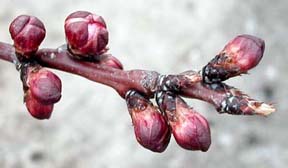Southwest Michigan fruit update
April showers bring infection periods to Southwest Michigan.
Last week was cool with highs near 50°F and lows near 30°F. Three to four inches of snow Monday morning did no damage to fruit and other plants. Forsythia is still blooming. Daffodils and star magnolia have begun to bloom. Rain Friday and Saturday (April 16-17) resulted in apple scab and mummy berry infection periods. The outlook for the week is for cool wet weather through Wednesday. Highs will be near 50°F and lows near freezing. Check for the closest weather station at: enviroweather.msu.edu. There are many fruit related prediction tools on Enviro-weather.
Tree fruit
Bud development has been slow due to the cool weather. There has been no loss to spring freeze injury. At this stage, overnight lows in the low 20s can cause damage to the most advanced fruits. There is pronounced north to south variation in the region in fruit development. Southern areas are a week or more ahead of northern areas. There is also a lesser variation from east to west with areas away from the lake more advanced.
Apricots are at calyx red and can withstand 22°F with little damage. We should see first white when we see warmer weather.

The red calyx of apricot flower buds will soon open to reveal the white petals.
Peaches are at green calyx and can withstand temperatures below 20°F. Leaf buds are showing about 1/8 inch green. Copper programs to suppress bacterial spot on disease prone sites and varieties can start now. Winter injury is apparent in lower sites away from the lake.
Sweet cherry buds are green side to green tip and would be damaged by temperatures below 25°F. Trees on Gisela rootstocks are close to budburst.
Tart cherries buds are at green tip and will be damaged at 26°F. There is a wide variation in crop load in the orchards.
In plums, Japanese plums are well advanced at tight cluster. European plums are at white side.
Apples are generally at green tip to early tight cluster, and are now susceptible to apple scab. Growers can use the scab infection tool on MSU’s Enviro-weather website to track infection periods. Use of copper to help suppress fire blight should go on before tight cluster in order to minimize russet. There is wide variation in apple development between varieties on the same site
Pears are at full swell and pear psylla are out when warm weather returns.
Small fruit
Grape buds are moving past scale crack to early swell. Vinifera grapes are less advanced. There is still time to make an application of copper or sulfur to help reduce disease inoculum of phomopsis and other diseases.
Blueberry flower buds are swollen and leaf buds are moving. Early variety fruit buds are beginning to burst. The most advanced leaf buds at the tips of the shoot have about 1/8 inch of green tissue exposed. Mummy berry apothecia are emerging from the mummies. The most advanced apothecia are about 1/8 inch wide and capable of releasing spores. Most apothecia are just emerging. Growers need to be prepared to protect against mummy berry shoot blight.
Strawberries have new leaves emerging from the crown. The flower trusses are not yet visible. With the flowers in the ground, strawberries can easily withstand temperatures below 10°F.
Brambles have about ¼ inch of green tissue showing. Applications of lime sulfur will help reduce anthracnose in plantings were this disease is a problem. Winter injury is becoming more apparent.



 Print
Print Email
Email


